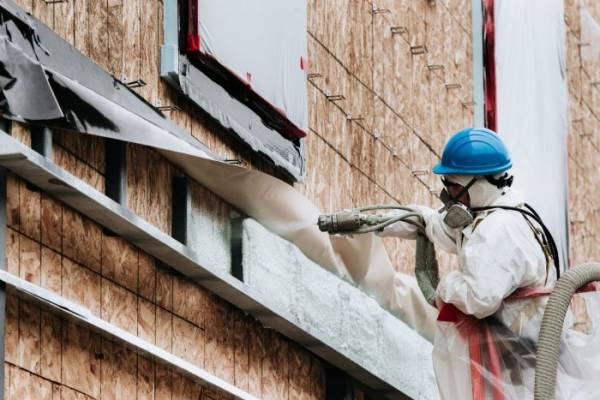The Future is Green: Spray Foam Insulation Meets Eco Building Requirements with HFO
13 Jul 2021

For most of us, the pandemic has impacted our life in one way or another. We are spending more time at home with family and adhering to safety measures like physical distancing as a requirement to keep everyone healthy. The new normal has forced us to recalibrate our lives and our impact on the environment around us. We’ve learned there are consequences to our actions that dictate the overall health of our planet. According to the World Health Organization (WHO), climate change impacts can increase the risk of emerging infectious diseases in the human population. In our efforts for post-COVID recovery we see people putting more focus on their health, family, communities, and the planet to effectuate a more sustainable economy and way of life. People are reassessing their homes and the direct role it plays in their health and well-being. Meanwhile builders are reassessing the role they play in home building.
Environmentally friendly building proponents are embracing the big picture and growth of the green building materials market in Canada and worldwide. The overall market is expected to grow by $187.4 billion to 2027, driven by a revised compounded annual growth rate (CAGR) of 8.6 per cent. Furthermore, research is showing that insulation, one of the product segments analyzed and sized, is forecasted to grow at a CAGR of 6 per cent and reach a market size of $71.1 Billion. (1)
Propelling Forward with Green Build in Mind
The major drivers for the growth in Spray Polyurethane Foam (SPF) are increasing building and construction activities that focus on climate change prevention, the interest in retrofitting homes, the need to re-purpose existing buildings, stringent government regulations towards energy efficiency, and a high demand for green building insulation. Wall insulation will remain the largest application over the period of now till 2024 due to the air tightness, moisture barrier, and energy efficiency properties of spray foam insulation. Within this market, spray foam for residential builds will remain the largest end use industry and it is also expected to witness the highest growth during the forecast period due to increasing use of green technologies that are incorporated into residential constructions to reduce energy consumption. (2)
With acceptance and collaboration around the Montreal and Kyoto Protocols and in support of today’s green building standards and certification systems, we are experiencing another spray foam insulation (SPF) phenomenon. SPF players are committed to innovations that are better for the environment and are aiming by January 2021 to replace hydrofluorocarbons (HFCs) with the most advanced in HydrofluoroOlefins (HFO) blowing agent technologies.
Builders who are still using HFC blowing agents along with architects, specifiers, interior designers, and general contractors are getting ready for the impact of the SPF change and preparing for the switch to HFOs. They are also educating their customers/homeowners on the benefits of HFO based spray foam insulation. Huntsman Building Solutions has been taking the necessary steps for this day by innovating products with new, lower global warming potential alternatives and our Building Science teams have been educating stakeholders on the products’ efficiencies and overall benefits.
An Eco-Friendly Product that Meets Builder and Consumer Requirements
How does new and improved SPF insulation benefit the market? It is a better designed alternative for environmentally conscious building professionals and homeowners. It acts as an ultra-low global warming potential (GWP) insulation with superior spray-ability, adhesion, and compressive strength. This insulation is compliant with the Paris, Kyoto, and Montreal Protocols, an internationally accepted agreement to lower the use of GWP gases. Our own Heatlok Soya HFO closed-cell product has a GWP 1 rating, which is 99.9 per cent lower than traditional blowing agents and it contains a total of 22 per cent recycled plastic and renewable soya oil content. Just one of our resin drums contains up to 3000 plastic bottles that are diverted from landfills. Spray foam insulation with this new blowing agent is greener than ever.
Today’s SPF insulation has a broad range of advantages over its predecessors, which includes better airtight building envelopes, stronger structural support, moisture control, and higher energy cost savings (more over other forms of insulation). The product provides outstanding, high performance options for projects in the residential space. It has many other great properties, such as being tested and certified as an exceptional air barrier, vapour retardant, water barrier, thermal insulator, and is flood resistant – perfect for the extreme weather cases we experience in Canadian climate. Spray foam also blocks and protects against harmful gases like Radon that is the second leading cause of lung cancer in Canada.
The insulation properties of HFO are comparable to its predecessors, in that building owners will still experience effectiveness against mould and mildew, and it limits the number of outdoor irritants like pollen, dust, and other allergens from entering the indoor space. It also blocks drafts and lowers the cost of heating and cooling.
What Builders Need to Know about the Transition
It’s important that builders hire certified SPF insulation experts and talk with them about how the switch from HFC to HFO based insulation products will impact their business and customers. They need to learn more about HFO product benefits and be able to see and trial the materials as the industry makes its foray into these new systems – they need to understand how HFO products work in terms of yield, sprayability, and adhesion, as well as the benefits to customers so they can in turn educate and sell it.
A couple of other things that builders should keep in mind as they transition: they should be aware of any project work they are bidding on in 2021 and if they will be using an HFC or HFO product.
Author: Simon Baker
Simon Baker is the President of Huntsman Building Solutions. Formerly the global president of Demilec, he is a seasoned international executive with extensive experience in polyurethanes.
